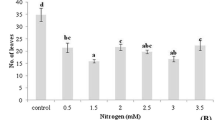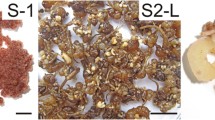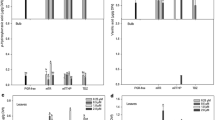Abstract
The alkaloids of Uncaria tomentosa micropropagated plantlets and root cultures were isolated and identified by NMR and mass spectrometry. Plantlets yielded pteropodine (1), isopteropodine (2), mitraphylline (3), isomitraphylline (4), uncarine F (5), speciophylline (6), rhynchophylline (7) and isorhynchophylline (8). In plantlets growing under continuous light, tetracyclic alkaloids 7 and 8 decreased from 20 ± 1.8 at 2 months to 2.2 ± 0.33 mg/g dry wt at 6 months, while the pentacyclic alkaloids 1–4 increased from 7.7 ± 1.4 to 15 ± 0.05 mg/g dry wt, supporting their biogenetic conversion. Micropropagated plantlets produced four times more alkaloids (27.6 ± 3.1 mg/g dry wt) than greenhouse plants. Plantlet roots yielded 3, 4, 8 and the glucoindole alkaloids 3α-dihydrocadambine (9) and dolichantoside (10), the last one not previously found in Uncaria.



Similar content being viewed by others
References
Achenbach H, Benirschke M (1997) Confirmation of the absolute configuration of dolichantoside and isodolichantoside by synthesis from (–)-secologanin. Phytochemistry 44:1387–1390
Arbain D, Putri MM, Sargent MV, Syarif M (1993) The alkaloids of Uncaria glabrata. Austr J Chem 46:863–872
Campos-Tamayo F, Hernández-Domínguez E, Vázquez-Flota F (2008) Vindoline formation in shoot cultures of Catharanthus roseus is synchronously activated with morphogenesis through the last biosynthetic step. Ann Bot 102:409–415
Coune C, Angenot L (1978) Dolichantoside, a new alkaloid from Strychnos gossweileri Exell. Planta Med 34:53–56
Endo K, Oshima Y, Kikuchi H, Koshihara Y, Hikino H (1983) Hypotensive principles of Uncaria hooks. Planta Med 49:188–190
Feria-Romero I, Lazo E, Ponce-Noyola T, Cerda-García Rojas CM, Ramos-Valdivia AC (2005) Induced accumulation of oleanolic acid and ursolic acid in cell suspension cultures of Uncaria tomentosa. Biotechnol Lett 27:839–843
Frédérich M, Hayette MP, Tits M, De Mol P, Angenot L (2001) Reversal of chloroquine and mefloquine resistance in Plasmodium falciparum by the two monoindole alkaloids, icajine and isoretuline. Planta Med 67:523–527
García Giménez D, García Prado E, Sáenz Rodríguez T, Fernández Arche A, De la Puerta R (2010) Cytotoxic effect of the pentacyclic oxindole alkaloid mitraphylline isolated from Uncaria tomentosa bark on human Ewing’s sarcoma and breast cancer cell lines. Planta Med 76:133–136
Heitzman ME, Neto CC, Winiarz E, Vaisberg AJ, Hammond GB (2005) Ethnobotany, phytochemistry and pharmacology of Uncaria (Rubiaceae). Phytochemistry 66:5–29
Huerta-Heredia AA, Marín-López R, Ponce-Noyola T, Cerda-García-Rojas CM, Trejo-Tapia G, Ramos-Valdivia AC (2009) Oxidative stress induces alkaloid production in Uncaria tomentosa root and cell cultures in bioreactors. Eng Life Sci 9:211–218
Jiao Y, Lau OS, Deng XW (2007) Light-regulated transcriptional networks in higher plants. Nat Rev Genet 8:217–230
Kihara T, Ishihara T, Endo K, Hikino H (1985) Hypotensive action of 3α-dihydrocadambine, an indole alkaloid glycoside of Uncaria hooks. Planta Med 51:424–427
Kohda H, Namera A, Koyama A, Yamasaki K, Tani T (1996) Indole alkaloid production in callus cultures of Uncaria rhynchophylla (Miq.) Miquel. Chem Pharm Bull 44:352–357
Laus G, Brössner D, Senn G, Wurst K (1996) Analysis of the kinetics of isomerization of spiro oxindole alkaloids. J Chem Soc Perkin Trans 2:1931–1936
Laus G, Brössner D, Keplinger K (1997) Alkaloids of peruvian Uncaria tomentosa. Phytochemistry 45:855–860
López-Juez E, Devlin PF (2008) Light and the control of plant growth. In: Bogre L, Beemster G (eds) Plant growth signalling. Plant cell monographs, vol 10. Springer, Berlin, pp 223–242
Ohmori O, Kumazawa K, Hoshino H, Suzuki T, Morishima Y, Kohno H, Kitajima M, Sakai S, Takayama H, Aimi N (1998) Final solution on the long-standing structural arguments on the C-3 stereochemistries of three glucoindole alkaloids: palicoside, dolichantoside, and isodolichantoside—through chemical conversions and spectroscopic studies. Tetrahedron Lett 39:7737–7740
Paradowska K, Wolniak M, Pisklak M, Glinski JA, Davey MH, Wawer I (2008) 13C, 15N CPMAS NMR and GIAO DFT calculations of stereoisomeric oxindole alkaloids from cat’s claw (Uncaria tomentosa). Solid State Nucl Magn Reson 34:202–209
Pereira RCA, Valente LMM, Pinto JEBP, Bertolucci SKV, Bezerra GM, Alves FF, dos Santos PFP, Benevides PJC, Siani AC, Rosario SL, Mazzei JL, d’Avila LA, Gomes LNF, de Aquino-Neto FR, Emmerick ICM, Carvalhaes SF (2008) In vitro cultivated Uncaria tomentosa and Uncaria guianensis with determination of the pentacyclic oxindole alkaloid contents and profiles. J Braz Chem Soc 19:1193–1200
Seki H, Takayama H, Aimi N, Sakai S, Ponglux D (1993) A nuclear magnetic resonance study on the eleven stereoisomers of heteroyohimbine-type oxindole alkaloids. Chem Pharm Bull 41:2077–2086
Shellard EJ, Houghton PJ (1974) Mitragyna species of Asia. XXVI. Further in vivo studies using 14C-alkaloids, in the alkaloidal pattern in young plants of Mitragyna parvifolia grown from seed obtained from Sri Lanka (Ceylon). Planta Med 25:80–87
Takayama H, Kitajima M, Kogure N (2005) Chemistry of indole alkaloids related to the corynanthe-type from Uncaria, Nauclea and Mitragyna plants. Curr Org Chem 9:1445–1464
Toure H, Babadjamian A, Balansard G, Faure R, Houghton PJ (1992) Complete 1H and 13C chemical shift assignments for some pentacyclic oxindole alkaloids. Spectroscopy Lett 25:293–300
Zhou J, Zhou S (2010) Antihypertensive and neuroprotective activities of rhynchophylline: the role of rhynchophylline in neurotransmission and ion channel activity. J Ethnopharmacol 132:15–27
Acknowledgments
This work was supported by Consejo Nacional de Ciencia y Tecnología (CONACYT Grant 105019). A. Huerta-Heredia thanks CONACyT-Mexico for a doctoral fellowship (199757). We are grateful to Professor Michel Frédérich, Institut de Pharmacie, Université de Liège, Belgium, for a generous gift of dolichanthoside. We wish to thank C. Fontaine for technical support.
Author information
Authors and Affiliations
Corresponding author
Rights and permissions
About this article
Cite this article
Luna-Palencia, G.R., Huerta-Heredia, A.A., Cerda-García-Rojas, C.M. et al. Differential alkaloid profile in Uncaria tomentosa micropropagated plantlets and root cultures. Biotechnol Lett 35, 791–797 (2013). https://doi.org/10.1007/s10529-012-1128-8
Received:
Accepted:
Published:
Issue Date:
DOI: https://doi.org/10.1007/s10529-012-1128-8




